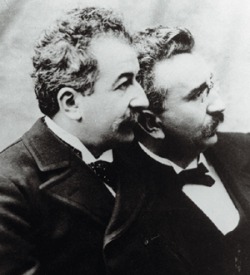The Girl in The Café (2005)
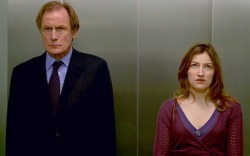
“Sometimes it falls upon a generation to be great. You can be that great generation.” Nelson Mandela
With a well-constructed plot, admirable characterization, and a deeply interesting message, The Girl in the Café attempts to address the idea of global poverty in the midst of an unlikely love story between a tired old man and enigmatic young woman. Lawrence has worked too hard for his job for too long while Gina has a mysterious past she is unwilling to confront. They meet in a side café in London and develop a relationship of awkward yet poetic and deeply profound consequences.
The camera angles and coloring are deeply significant to characterizing both Lawrence and Gina. The film begins with a non diegetic somber Damien Rice ballad playing amidst a rainy morning in grey, mute coloring – only Lawrence is seen. When the two first meet, the lighting is yellow and casting down on them, designating their interactions as the most important element of the scene. The camera individually pans from each of their faces, further demonstrating that they are strangers and cannot personally relate to each other yet. Camera technique is essential to developing characters at the Summit conference. In one pivotal scene, when Gina’s hard headedness first emerges, the camera moves in a dizzying circle around Lawrence and his colleagues. This signifies that Gina is now part of Lawrence’s politic and personal life – she is a fluid element from which he gains strength for his judgments.
Irony is a central element to the development of this complex plot. Lawrence talks about finding love in unlikely places (Marks&Spencer’s) when he first meets Gina, totally unaware of the influence she will have upon him. Furthermore, the simple irony of Lawrence meeting the woman he will adore most in such an off hand way contributes to how the film takes such a giant universal issue and displays it tandem with a love story of dubious proportions.
Maintaining an understated and sometimes impenetrable motive, The Girl in the Café is a multifaceted film, touching on many different human complexities. Superficially, Lawrence and Gina embark on a journey of unsure bounds, yet the central message is concerned with how far one person will go for what he or she thinks is right. Gina represents those people in the world who will go to unfound lengths to prevent poverty, hunger, and unnecessary death; Lawrence represents those people unsure of how to put morals above corporate needs; and the Summit attendees represent the businessmen unwilling to compromise their economy. As the ad for the movie states: “Love can’t change the world. But it’s a start.”
With a well-constructed plot, admirable characterization, and a deeply interesting message, The Girl in the Café attempts to address the idea of global poverty in the midst of an unlikely love story between a tired old man and enigmatic young woman. Lawrence has worked too hard for his job for too long while Gina has a mysterious past she is unwilling to confront. They meet in a side café in London and develop a relationship of awkward yet poetic and deeply profound consequences.
The camera angles and coloring are deeply significant to characterizing both Lawrence and Gina. The film begins with a non diegetic somber Damien Rice ballad playing amidst a rainy morning in grey, mute coloring – only Lawrence is seen. When the two first meet, the lighting is yellow and casting down on them, designating their interactions as the most important element of the scene. The camera individually pans from each of their faces, further demonstrating that they are strangers and cannot personally relate to each other yet. Camera technique is essential to developing characters at the Summit conference. In one pivotal scene, when Gina’s hard headedness first emerges, the camera moves in a dizzying circle around Lawrence and his colleagues. This signifies that Gina is now part of Lawrence’s politic and personal life – she is a fluid element from which he gains strength for his judgments.
Irony is a central element to the development of this complex plot. Lawrence talks about finding love in unlikely places (Marks&Spencer’s) when he first meets Gina, totally unaware of the influence she will have upon him. Furthermore, the simple irony of Lawrence meeting the woman he will adore most in such an off hand way contributes to how the film takes such a giant universal issue and displays it tandem with a love story of dubious proportions.
Maintaining an understated and sometimes impenetrable motive, The Girl in the Café is a multifaceted film, touching on many different human complexities. Superficially, Lawrence and Gina embark on a journey of unsure bounds, yet the central message is concerned with how far one person will go for what he or she thinks is right. Gina represents those people in the world who will go to unfound lengths to prevent poverty, hunger, and unnecessary death; Lawrence represents those people unsure of how to put morals above corporate needs; and the Summit attendees represent the businessmen unwilling to compromise their economy. As the ad for the movie states: “Love can’t change the world. But it’s a start.”
Salut Cousin! (1996)
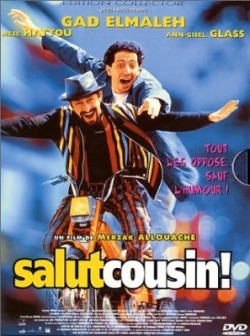
A combination of bad acting, slow plot lines, and outdated styles, Allouache’s Salut Cousin! serves to poorly portray the struggle of Algerians, specifically two cousins, in a Parisian setting. Alilo travels from Algeria to obtain dresses for resale, only to lose his only contact’s information as soon as he arrives in Paris. Mok, his cousin, brings him to his apartment in the 18th arrondissment, revealing a slightly rougher view of Paris than Alilo was originally picturing. Mok characterizes the place as a haven for artists and intellectuals, but it is plainly just a Third World slum filled with tightly knit and colorful neighbors. Mok and Alilo have many interesting, some tragedy-tinged adventures over the five days it takes them to find the suitcase. Becoming sick after eating eleven bananas in a row, witnessing Mok painfully booed off stage, and attempting to save a woman from skinheads, Alilo realizes that being Algerian in Paris involves a difficult, almost impossible, process of assimilation.
Mok and Alilo are definitely foil characters. While Mok is a pathological liar, rapper, and dwells upon his cultural difficulties, Alilo is more straightforward and willing to serve others without a price. Mok represents the struggle of an outsider trying to be inside the suave Parisian culture while Alilo is the cousin with realistic expectations of actually acquiring the French identity, without a cultural boundary.
Ironically, this film portrays emigrants as people caught in the middle of society. They are native Algerians trying to make Paris their home, yet the neighborhood they live in cannot sustain their successful integration. Furthermore, the expectations of Alilo and Mok as characters change as the plot develops. While Alilo originally comes from Algeria to Paris to visit his cousin, as an outsider, Mok is deported back to Algeria at the end of the film.
The French term “salut” takes on two meanings in the film – it is both Alilo saying hello to his cousin once he arrives in Paris and Alilo saying goodbye when Mok must go back to Algeria. The question of emigration and the definition of home become heavily integrated in this irony, because the people portrayed struggle to keep their native Algerian identities while attempting to add Parisian culture to their lifestyle.
Alilo’s infatuation with Fatoumata is funny at times but very stereotypical. It is obvious that he is falling in love with her throughout the film, with his attempt to save her in the telephone booth, his insistent, longing gaze, and his dream of her seducing him but it is never reciprocated until the end of the film. Ironically, Alilo and Fatoumata are from completely different cultures, coming together in Paris, and eventually fall in love, expunging the idea that emigration is isolated.
Trying to capture the mood of this film is the hardest part of analyzing this film. While it touches on the serious issue of emigration, it attempts to be funny and provide comic relief where it is most often inappropriate. The most poignant part of the film is visiting Mok’s family and witnessing how they have struggled to acculturate to Parisian standards. In those scenes, the audience achieves a sense of emotional relatability absent throughout the rest of the film. What make the mood so difficult to pinpoint is the extreme “in between” nature of this film: Alilo and Mok want to be successful in Paris but their Algerian roots cannot be dismissed without consequence. Whereas many other films do address people who are unsure of themselves, this film does not quite develop characters and situations with a solid origin. With too many plot lines, not enough characterization, and the failure to convey a central message, Salut Cousin! attempts to address cross cultural exchanges and its hardships without much substance.
The film tries combines the humor of the two cousins' cultural clash and a strong sense of the isolation and desperation that Mok feels as an outsider in France. Yet, it comes up short because of the weak characterization and unlikely situations in which the characters are placed. Its dated style and frustrating scenes contribute to the desperate mood of an outsider Algerian unsure of his Parisian status. I would not recommend this film to those who seek a film of real proportions – it fulfills no expectations and fails to develop a ripe, believable plot.
Russian Dolls (2005)
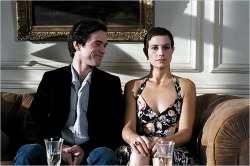
As the continued story of Xavier struggling to realize his individual reality, Klapisch’s Russian Dolls is a film that explores how young people come to terms with their lives on every level, including social, romantic, academic, and career aspects. While its prequel, L’auberge espagnole, was a mostly fun and lighthearted film, Russian Dolls delves deeper into what it means to find what you want in life and how to keep the people you love close. The plot becomes more complicated: Xavier’s ex-girlfriend, Martine, has illegitimately had a child, but he still sees her and serves as her confidant; Xavier has to move in with his lesbian friend, Isabelle; and then he goes to live with Wendy in London to write a script for a cliché soap opera. There are also fewer characters, which allows for deeper characterization of those who are presented. Xavier is hot headed and quick to react without thinking, Martine is an avid environmentalist, and Wendy’s past relationships reveal that she is attracted to imperfection.
Irony plays a huge role in this film. Both Xavier and Martine are single and frustrated with their romantic situations, yet neither of them suggest starting their relationship over again. The title, Russian Dolls, is ironic because William’s fiancé is Russian and Xavier compares every girl he has been with to “les poupées russes” because they were so distant and unattainable for his lifestyle. Restricted to Xavier’s point of view, the narrative range brings the audience deeper into his thoughts, desires, and worries, constructing a relatable emotional relationship as the plot develops. Portrayed as a troubled young woman who cannot seem to pick the right partner, Wendy becomes a pivotal support for Xavier’s realization of what he really wants in life. She is the constant and balance that he was seeking in all of his other relationships.
The camera work brings the playfulness of the film to life. Sequences are sped up, one scene is broken into digital patches, the timeline is scrambled (Xavier has flashbacks to his previous lover, Neus) and fantasies embellish reality. Klapisch manages to digitally divide frames into collages of memory, perfectly in tune with the Xavier’s freedom to move from country to country, and bed to bed.
Russian Dolls is a film about the young, foolish, yet vibrantly alive European urbanites. Its plot urges Xavier to make choices about his future while presenting a wildly amusing set of circumstances and characters to help him along the way. As a viewer, you will leave this film wanting to know these people and wanting the best for them. Offering novel camera techniques, touristic views of the most beautiful cities in the world, and a quirky cast, Russian Dolls is a film about earnest reflection and true self-discovery.
Irony plays a huge role in this film. Both Xavier and Martine are single and frustrated with their romantic situations, yet neither of them suggest starting their relationship over again. The title, Russian Dolls, is ironic because William’s fiancé is Russian and Xavier compares every girl he has been with to “les poupées russes” because they were so distant and unattainable for his lifestyle. Restricted to Xavier’s point of view, the narrative range brings the audience deeper into his thoughts, desires, and worries, constructing a relatable emotional relationship as the plot develops. Portrayed as a troubled young woman who cannot seem to pick the right partner, Wendy becomes a pivotal support for Xavier’s realization of what he really wants in life. She is the constant and balance that he was seeking in all of his other relationships.
The camera work brings the playfulness of the film to life. Sequences are sped up, one scene is broken into digital patches, the timeline is scrambled (Xavier has flashbacks to his previous lover, Neus) and fantasies embellish reality. Klapisch manages to digitally divide frames into collages of memory, perfectly in tune with the Xavier’s freedom to move from country to country, and bed to bed.
Russian Dolls is a film about the young, foolish, yet vibrantly alive European urbanites. Its plot urges Xavier to make choices about his future while presenting a wildly amusing set of circumstances and characters to help him along the way. As a viewer, you will leave this film wanting to know these people and wanting the best for them. Offering novel camera techniques, touristic views of the most beautiful cities in the world, and a quirky cast, Russian Dolls is a film about earnest reflection and true self-discovery.
Amélie (2001)

With rich language, vibrant colors, and an unforgettable cast, Jean-Pierre Jounet’s Amélie is a universal film, exploring one young woman’s journey to helping others while incorporating an array of true human emotions to which each viewer can relate. It is a uniquely styled, magic realist comedy about love, photo booths and the strangeness of life.
The narrator of this film is an internal diegetic element essential to the development of both the plot and characterization. With his deep voice and objective point of view, he humorously introduces each character by what they do and do not like. Furthermore, he tells us what Amélie is thinking, feeling, questioning, creating a very personal character depth. He develops Amélie from a lonely girl into a woman who discovers that her purpose in life is to unite similar souls and find true love.
There is a very interesting use of cause and effect in this film, contributing to the development of the plot. The coverage of Princess Diana’s accident on the evening news catches Amélie attention, leading her to drop her bottle cap in surprise, which rolls into the floorboard tile, which reveals the tin box that motivates the action for the rest of the film. Choppy camerawork and quick transitions add to the playful nature of the film, while reiterating that Amélie is intent on becoming a regular “do-gooder.” The romantic twists combined with its fantastical nature developing the fast paced plot into a “rumination of loss and the perils of being too playful” (NY Times, 2001).
With the use of quirky film techniques, the engaged narrator, and an irresistible main character, Jeunet creates a film with heart and charm. It is wildly amusing and always touching, serving to show the audience how one woman can change the lives of so many through her optimism and focus on “doing good” for others.
The narrator of this film is an internal diegetic element essential to the development of both the plot and characterization. With his deep voice and objective point of view, he humorously introduces each character by what they do and do not like. Furthermore, he tells us what Amélie is thinking, feeling, questioning, creating a very personal character depth. He develops Amélie from a lonely girl into a woman who discovers that her purpose in life is to unite similar souls and find true love.
There is a very interesting use of cause and effect in this film, contributing to the development of the plot. The coverage of Princess Diana’s accident on the evening news catches Amélie attention, leading her to drop her bottle cap in surprise, which rolls into the floorboard tile, which reveals the tin box that motivates the action for the rest of the film. Choppy camerawork and quick transitions add to the playful nature of the film, while reiterating that Amélie is intent on becoming a regular “do-gooder.” The romantic twists combined with its fantastical nature developing the fast paced plot into a “rumination of loss and the perils of being too playful” (NY Times, 2001).
With the use of quirky film techniques, the engaged narrator, and an irresistible main character, Jeunet creates a film with heart and charm. It is wildly amusing and always touching, serving to show the audience how one woman can change the lives of so many through her optimism and focus on “doing good” for others.
9'11"01 (2002)
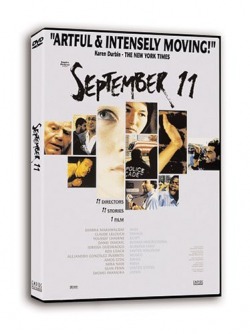
In this collection of eleven short pieces, director Alain Brigand attempts to portray the events of September 11th, 2001 on an international background. By asking directors from every continent and many cultures to contribute a film they feel is pertinent to their peoples’ history, he manages to create a global response to single historical event. While some are allegorical, some true stories, and some first person narratives, this film generates a variety of sentiments responding to the event rather than dwelling on the tragedy.
Even though the films are connected by one event, they take radically different approaches to portraying its effect on the world. The political Chilean piece, directed by Ken Loach, is a propaganda letter to the Americans illuminating the violence and corrupt history of Chile, disregarding what America felt in response to its own calamity. In contrast, the Sean Penn directed piece is abstract, pointing to different levels of consciousness awakened by September 11th as illustrated by the elderly man grieving over his wife and subsequently awakened to his harsh reality of loneliness when the twin towers fall. Furthermore, the Japanese piece is questioning a Holy War and whether it can be used as justification for killing more people. A freedom of choice and interpretation, given by Alain Brigand, solidifies that each country is different and must react in its own way to such a catastrophic event.
With an international perspective, this artistic project realizes what other countries feel in relation to America’s tragedy. While it is a collective film, it is useful to stop between segments and analyze them individually, rather than watching it as a whole. Because of its emotional intensity and personal nature, especially to American citizens, this film is overwhelmingly powerful in presenting subjective issues. The camerawork, lighting, and technical aspects of the film differ with each segment, enlightening the audience to the comprehensive effect that the event of September 11th had on the world. It is an innovative yet complicated response to a terrorist attack that changed the dynamics of history. Chilling, uplifting, and thought provoking at once, this is an artistic film exploring how one event can connect the world in one medium.
Even though the films are connected by one event, they take radically different approaches to portraying its effect on the world. The political Chilean piece, directed by Ken Loach, is a propaganda letter to the Americans illuminating the violence and corrupt history of Chile, disregarding what America felt in response to its own calamity. In contrast, the Sean Penn directed piece is abstract, pointing to different levels of consciousness awakened by September 11th as illustrated by the elderly man grieving over his wife and subsequently awakened to his harsh reality of loneliness when the twin towers fall. Furthermore, the Japanese piece is questioning a Holy War and whether it can be used as justification for killing more people. A freedom of choice and interpretation, given by Alain Brigand, solidifies that each country is different and must react in its own way to such a catastrophic event.
With an international perspective, this artistic project realizes what other countries feel in relation to America’s tragedy. While it is a collective film, it is useful to stop between segments and analyze them individually, rather than watching it as a whole. Because of its emotional intensity and personal nature, especially to American citizens, this film is overwhelmingly powerful in presenting subjective issues. The camerawork, lighting, and technical aspects of the film differ with each segment, enlightening the audience to the comprehensive effect that the event of September 11th had on the world. It is an innovative yet complicated response to a terrorist attack that changed the dynamics of history. Chilling, uplifting, and thought provoking at once, this is an artistic film exploring how one event can connect the world in one medium.
L'auberge Espagnole (2003)
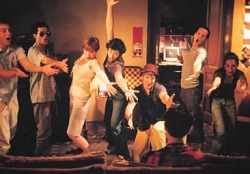
Presented with the possibility of becoming a successful businessman like his father, Xavier moves from his home in Paris to Barcelona to learn more about Spanish economics and culture in the 2003 film, The Spanish Apartment. After enrolling in the Erasmus program, he leaves boring parents and a devoted girlfriend for a more uncertain, exciting future. He finally settles in a crazy apartment with what he calls “l’auberge espagnole “ – a European pudding – of roommates. The film is told through Xavier’s eyes, with dialogue in French, Spanish, and English, reiterating the chaotic, unorganized, and ironic nature of his life in Barcelona. The aptly named title reveals that the apartment will be a defining part of his life, giving him experiences and friends to change his life from one of mundane options to one of exciting possibilities. Irony also plays a big role in the film, evident when Martine leaves after her catastrophic visit to Xavier in Barcelona. As she goes up the escalator, she turns back to him and turns back around before Xavier can turn back to her. This signifies the beginning of the end of their relationship and the ambiguity of how Xavier feels about their love.
The camera technique is noticeably different when in Paris compared to Barcelona. With editing and camera tricks, split screens, and insets, Klapisch spruces up Parisien scenes while presenting Barcelona with a more straightforward method. With a succession of incidents offered as the screenplay, populated by active characters who bring their own crises to the table, this hectic film, says film critic Kauffmann, brings the question of individual happiness and strength to the audience. While a farewell party gives closure to his experience in Barcelona, Xavier returns to Paris to begin his adult life. When he realizes that becoming a businessman would ruin his individuality, as a result of Barcelona’s adventures, Xavier takes off – literally- to become what he has always wanted to be: a writer. Its formal freshness and energy make up for its lack in depth of character, with relatable, and fresh acting. Managing to find the sincerity in important sequences without developing a heavy-handed mood, the film avoids sensationalizing Xavier's unlikely adventures while heightening the conflict between the corporate world and a student's struggle to find his self-identity.
The camera technique is noticeably different when in Paris compared to Barcelona. With editing and camera tricks, split screens, and insets, Klapisch spruces up Parisien scenes while presenting Barcelona with a more straightforward method. With a succession of incidents offered as the screenplay, populated by active characters who bring their own crises to the table, this hectic film, says film critic Kauffmann, brings the question of individual happiness and strength to the audience. While a farewell party gives closure to his experience in Barcelona, Xavier returns to Paris to begin his adult life. When he realizes that becoming a businessman would ruin his individuality, as a result of Barcelona’s adventures, Xavier takes off – literally- to become what he has always wanted to be: a writer. Its formal freshness and energy make up for its lack in depth of character, with relatable, and fresh acting. Managing to find the sincerity in important sequences without developing a heavy-handed mood, the film avoids sensationalizing Xavier's unlikely adventures while heightening the conflict between the corporate world and a student's struggle to find his self-identity.
Run Lola Run (1998)
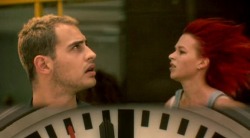
First presented with the futility of asking questions, the audience is immediately drawn to the kinetic style of the 1998 German film, Run Lola Run. As the plot progresses, we learn that Lola must find a way to get 100,000 marks in 20 minutes for her boyfriend, Manni, before his mob boss finds out he has lost it on the subway and kills him. With her "compact and sturdy form, her grip on the phone, her single-minded focus, her flaming aura of hair and her scream that shatters glass, Lola is an embodiment of will." (Wood, 2003) Embarking on three different attempts to get the money safely to Manni before he foolishly robs a store, Lola's great passion is the motivating source of the film. To prove herself, she has to come up with a solution - she must validate both her love and love itself. The emphasis in the dialogue is on action and what she can do to save Manni. Time plays a significant role in the film, signifying that life will pass by if we do not actively seek it. The breathless tempo and wrap around quality of the techno sounds that initiate and accompany Lola's runs add to the self-reflexive nature of the film, while adding persistence to the action at hand. Lola seems to learn subconsciously from each attempt, remembering how to cock a gun from the store with Manni in her first trial to hold her father hostage in the second. The title of the film is very appropriate as almost every time we see Lola, she is running with a purpose and drive so powerful that it is uncontainable. It accurately foreshadows much action of the film while implying the intensity and urgency evident throughout it.
Catherine Wood writes that she sees the film "as an illustration of the idea that the universe offer us the possibility of happiness, but we have to be together enough to trust the offer when, and if, we see it." I could not agree more with her analyzation of the film and her assertion that we, as humans with free will, are in control of our lives. Lola takes it upon herself to make sure that her life with Manni continues; the three scenarios symbolize how specific actions take us to specific endings. In the third storyline, Lola and Manni walk away unscathed with an extra 100,000 marks. Even though Lola could not get a hold of her father, like she had in the fatal previous two scenes, she improvised and went to a casino to get the money instead - and succeeded. The message is to be open to unexpected solutions. As humans, we must be willing, feeling, and thinking to have a life of balance and the potential for the universe to offer us chances, and the enjoyment out of every phase of life
Catherine Wood writes that she sees the film "as an illustration of the idea that the universe offer us the possibility of happiness, but we have to be together enough to trust the offer when, and if, we see it." I could not agree more with her analyzation of the film and her assertion that we, as humans with free will, are in control of our lives. Lola takes it upon herself to make sure that her life with Manni continues; the three scenarios symbolize how specific actions take us to specific endings. In the third storyline, Lola and Manni walk away unscathed with an extra 100,000 marks. Even though Lola could not get a hold of her father, like she had in the fatal previous two scenes, she improvised and went to a casino to get the money instead - and succeeded. The message is to be open to unexpected solutions. As humans, we must be willing, feeling, and thinking to have a life of balance and the potential for the universe to offer us chances, and the enjoyment out of every phase of life
Paris je t'aime (2006)
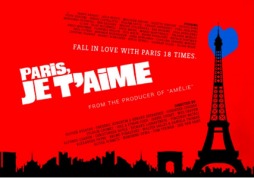
A collaboration of eighteen talented directors, the 2006 film Paris je t’aime crafts short stories about the cinema’s greatest love affair with a city. As the film progresses through almost all of Paris’s arrondissements, the audience becomes acquainted with almost every aspect and character of the city, regardless of race, gender, background or occupation. We are offered a smorgasbord of distinct styles as it compiles an unprecedented movie mix tape of poetic interludes, complete with famous actors, among them, American, French, and British. Because of its concentration on relationships, nostalgia for the past, and self-discovery, it conveys an overall mood of ironic romanticism; crossing boundaries and becoming appreciative of differences in types of love is a theme evident within each scene, as well as a connecting thread for the entire collection.
The beauty of the film is evident in its unusual panoramic view of a city’s lifestyle. It seems as if each situation is relatable and connected to other scenes, whether in style, characterization, or situation. A strong sense of love and connection is evident in the scene depicting a Spanish woman’s devotion to her baby girl, the Bastille scene of a husband falling back into love with his leukemia stricken wife, and even the abstract miming scene told by a young boy. Along with love comes tragedy: Hassan’s desperate attempt to connect with Sophie before he dies, as well as the cynical older couple in the Quartier Latin, discussing their divorce papers and poking fun at each other’s lifestyles. Even though the scenes are trying to depict different behaviors and habits of citizens of Paris, the scene has a central theme to it, aptly portrayed by the ironical American describing her experiences in the city. She ends with her realization of being alive and falling in love with Paris, giving significance to the title. Objective versus subjective truth is depicted most poignantly in the Place de Victoires scene. Having just lost her son, Suzanne dreams of her son with his beloved cowboys, providing closure and bridging the gap between grief and reality. Emotion plays a large role in Paris je t’aime, creating characterization and developing each scene with elements to which the audience can relate.
A masterful achievement, both as a film and as a heartfelt love letter to one of the world's most romantic cities, Paris je t’aime vibrates with life and passion. It approaches the subjects of joy, frustration, pain, sadness and devotion with an unfettered enthusiasm. Ironic in nature yet frank in portrayal of human tendencies, this film has real love for its subjects and themes. Complete with uneven plots, it succeeds in showing how Paris brings out the best in us and urges us to look deep inside ourselves for genuity of human emotion.
Daughter from Danang (2002)
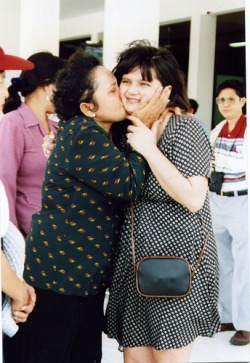
Initially presented with a bombardment of emotion, sound, and images, the 2002 documentary Daughter from Danang explores the cultural dissonance evident after the United States' efforts to save some Vietnamese children from their own government. Taken from her mother when she was 7 years old, Heidi recounts the unbelievably heartrending, emotional, astonishing story of her return to her homeland. Before Heidi leaves for Vietnam, the tone of the documentary is somewhat apprehensive but overall upbeat and excited for the reunification of daughter and mother after twenty two years of distant separation. However, there is a very apparent oppressiveness that Heidi feels when surrounded by her native family, shifting the tone to one of exasperation and discomfort. The Vietnamese culture resounds with close-knit bonds, intimate conversations, and relentless physical contact, none of which Heidi is accustomed to or willing to accept. Heidi's subjective truth of her return to her mother directly contrasts to the objective truth of the situation at hand - the complexity of losing a daughter to desperate circumstances and a historical event. While the filmmakers remain an illusion, the account of this tragic return is restricted to interviews with Heidi and her family, thus forcing the audience to create its own dimension of understanding of the situation. In addition, we are only told what the cameraman wants to show us, thus blurring the line between reality and clever manipulation of actual experiences. This documentary shows that the resulting disillusionment of a "happy ending" on top of an already stressful situation can be devastating for both parties. Heidi had no preparation for the culture shock, the forward nature of asking for fiscal support, or the close physical contact with which the Vietnamese represent their family connection; her mother, brothers, and sisters do not account for the fact that Heidi is indeed American and delve into what a typical Vietnamese family relationship would be. It is frustrating and difficult to watch, yet it is forthright in its honest portrayal of the cultural dissonance experienced by adopted people around the world. It is a sad portrayal of simple cultural misunderstanding, combined with the disappointment of lack of reconnect Heidi and her family experience
Goodbye Lenin! (2003)
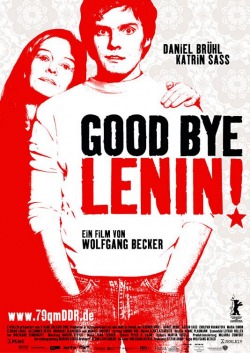
Classified as a German tragiocomedy film, Goodbye Lenin! was directed by Wolfgang Becker as part of the ostalgie movement in Eastern Germany. This powerful narrative seeks to explore the changes that occurred in the GDR when the Berlin wall came down and Germany became united under one government. Initially, the change to Western life was accepted by Easterners, but with the passing of time, they began to feel nostalgic aspects of regular daily life and culture in their former GDR. As a result, companies and media cater to this nostalgia by producing merchandise for the former eastern citizens - this film is the offspring of the ostalgie movement.
Cleverly manipulating time, the majority of the film is restricted to Alex's viewpoint as he attempts to take care of his ailing mother after she conveniently has a heart attack and falls into a coma right as East Germany becomes assimilated into the West. Reminiscent of the complex interchange between fact and fiction, there are historical flashbacks made to real television footage, historical records and new government policies, combined with Alex's attempt to recreate the GDR his mother loved. This successfully advances the plot in a fast-paced narrative focused on the changes that occured in East Germany after the fall of the Berlin Wall. Making the plot credible, the single scene of Alex rearranging his mother's war back to the way it was signifies his motives and foreshadowing the actions and situations to come. While Alex, Ariane, and Lara struggle to keep Christiane in the dark about the drastic changes that took place during her extended rest, there is a desperate, intense mood for the rest of the movie. Following Alex as he searches for old foods that his mother used to love, sleeps by her side, and accommodates her every need in decathlon of shopping trips, this narrative explores the true meaning of a "devoted" son while tackling the "pain and confusion that East Germans felt after the initial euphoria of freedom from their suppressive socialist party" (Fitzgerald, 2003).
Revealing how East Germans miss what their old society used to offer - old foods, markets, and smaller community - this film is dominated by action taken to preserve a lost civilization by magnifying its charm and success. Alex asserts that the country his mother left behind was a country she believed in; a country he kept alive till her last breath; a country that never existed in that form; a country that, in his memory, he will always associate with his mother
Cleverly manipulating time, the majority of the film is restricted to Alex's viewpoint as he attempts to take care of his ailing mother after she conveniently has a heart attack and falls into a coma right as East Germany becomes assimilated into the West. Reminiscent of the complex interchange between fact and fiction, there are historical flashbacks made to real television footage, historical records and new government policies, combined with Alex's attempt to recreate the GDR his mother loved. This successfully advances the plot in a fast-paced narrative focused on the changes that occured in East Germany after the fall of the Berlin Wall. Making the plot credible, the single scene of Alex rearranging his mother's war back to the way it was signifies his motives and foreshadowing the actions and situations to come. While Alex, Ariane, and Lara struggle to keep Christiane in the dark about the drastic changes that took place during her extended rest, there is a desperate, intense mood for the rest of the movie. Following Alex as he searches for old foods that his mother used to love, sleeps by her side, and accommodates her every need in decathlon of shopping trips, this narrative explores the true meaning of a "devoted" son while tackling the "pain and confusion that East Germans felt after the initial euphoria of freedom from their suppressive socialist party" (Fitzgerald, 2003).
Revealing how East Germans miss what their old society used to offer - old foods, markets, and smaller community - this film is dominated by action taken to preserve a lost civilization by magnifying its charm and success. Alex asserts that the country his mother left behind was a country she believed in; a country he kept alive till her last breath; a country that never existed in that form; a country that, in his memory, he will always associate with his mother
Battle of Algiers (1966)
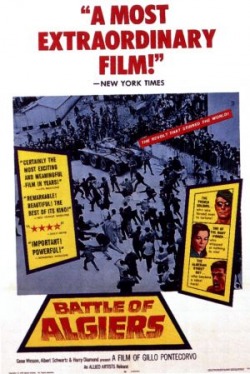
A combination of both factual and fictional elements, this narrative documentary blends the boundaries between history and fiction in relation to the Algerian war. Director Gille Pontecorvo hired his actors to be in the film yet he documents the true events of the war as he experienced them. Specifically, his objective is to explore the integral role of women and how they helped the insurgent Algerian movement prosper against the French.
Important to the overall mood of the film is the use of music during specific points in the film. A repetitive "hearbeat" type of drum music is used when the women are ordered to plant the bombs and when one woman is in the bar, obviously developing her plan. This use of music indicates intensity, suspension, and impending danger throughout the documentary. In contrast, the use of a heroic, romantic score of music when the bomb does go off suggests a slightly tragic satire of the Franco-Algerian relations and the violence it has incited.
While many commentators have taken this film to be a factual account, it cannot be relied upon for such a lofty event in history. Furthermore, there have been several allegations sugesting that this movie was used by terrorist groups around the world, proving to be more influential on a global scale. Although this could be true, it would be a purely subjective viewpoint and not an assertion that could be entirely proven.
This documentary raises the question of whether we should purely rely on a documentary for truth or not. It could be more subjective than we are aware, skewing our views as an audience dependent upon the film for accuracy pertaining to a specific event or time period in history. While The Battle of Algiers does introduce the foreign, minority side of the Algerian war, it might not be the best source of documentation for cold, hard facts in history.
Important to the overall mood of the film is the use of music during specific points in the film. A repetitive "hearbeat" type of drum music is used when the women are ordered to plant the bombs and when one woman is in the bar, obviously developing her plan. This use of music indicates intensity, suspension, and impending danger throughout the documentary. In contrast, the use of a heroic, romantic score of music when the bomb does go off suggests a slightly tragic satire of the Franco-Algerian relations and the violence it has incited.
While many commentators have taken this film to be a factual account, it cannot be relied upon for such a lofty event in history. Furthermore, there have been several allegations sugesting that this movie was used by terrorist groups around the world, proving to be more influential on a global scale. Although this could be true, it would be a purely subjective viewpoint and not an assertion that could be entirely proven.
This documentary raises the question of whether we should purely rely on a documentary for truth or not. It could be more subjective than we are aware, skewing our views as an audience dependent upon the film for accuracy pertaining to a specific event or time period in history. While The Battle of Algiers does introduce the foreign, minority side of the Algerian war, it might not be the best source of documentation for cold, hard facts in history.
The Lives of Others (2006)
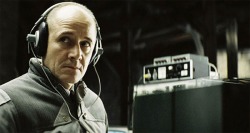
"The Lives of Others is haunted by a piece of music called “Sonata for a Good Man,” composed for the film by Gabriel Yared and, at the same time, magically familiar to some of its characters. Like the story that surrounds it — a suspenseful, ethically exacting drama, beautifully realized by the writer and director Florian Henckel von Donnersmarch— Mr. Yared’s piece is melancholy, elegant and complicated..." - New York Times, A.O. Scott, 2007. Unified in plot and narrative, this film explores the complexity of human emotions while embarking on a journey reminiscient of the corruption of Eastern Germany politics.
In this 2006 German film, the camera tells this narrative from the different views of each character. The audience is omniscient and we experience traits of each character that other characters do not necessarily know. Yet, our knowledge of each character and event fluctuates to create suspense and mystery throughout the narrative. Its focus is the life of Weisler and his endeavors to uphold personal principles that conflict with his political party. Weisler struggles with the moral dilemma between revealing Dreyman's secrets or remaing loyal to his profession, yet no one else in the film is aware of his internal battle.
A strong nondiegetic element of the film is the scores of music, played by specific instruments, performed during emotional scenes, such as when Dreyman thinks his beloved Christa-Marie is cheating on him. The difference between hearing and listening is apparent as recorded video is used to hear Dreyman and Christa-Marie's life together, while we as viewers listen to the music and dialogue with intense attention. In addition, warm colors are associated with tender emotions, while cold colors indicate hard, inhumane elements. The narrative range of the film is unrestricted and particularly omniscient, demonstrated by the audience's persistent knowledge of new developments before the characters are even aware of them. For example, the audience is aware that Wiesler hides the typewriter from the Stasi, while Dreyman, Christa-Marie, and the Stasi themselves are dumbfounded to find it gone.
As the narrative becomes more complicated, we delve further into the depths of the psychological states of each character. We learn Christa-Marie takes antidepressants to contend her feelings inadequacy in the acting world. In addition, the individual development of traits within each character seems to expand as the film reveals more of its plot.
This narrative is poignant, posing a "stark, difficult question — how does a good man act in circumstances that seem to rule out the very possibility of decent behavior? — it illuminates not only a shadowy period in recent German history, but also the moral no man’s land where base impulses and high principles converge...demonstrating astonishing visual and narrative rigor" (Scott, 2007). It highlights the psychology of socialism while exploring the intensity of human emotion faced with moral plight. Saluting humane ideology, Weisler's performance as a man torn between morals and politics is affecting, eye-opening, and effective in its portrayal of East Germany's corrupt government.
In this 2006 German film, the camera tells this narrative from the different views of each character. The audience is omniscient and we experience traits of each character that other characters do not necessarily know. Yet, our knowledge of each character and event fluctuates to create suspense and mystery throughout the narrative. Its focus is the life of Weisler and his endeavors to uphold personal principles that conflict with his political party. Weisler struggles with the moral dilemma between revealing Dreyman's secrets or remaing loyal to his profession, yet no one else in the film is aware of his internal battle.
A strong nondiegetic element of the film is the scores of music, played by specific instruments, performed during emotional scenes, such as when Dreyman thinks his beloved Christa-Marie is cheating on him. The difference between hearing and listening is apparent as recorded video is used to hear Dreyman and Christa-Marie's life together, while we as viewers listen to the music and dialogue with intense attention. In addition, warm colors are associated with tender emotions, while cold colors indicate hard, inhumane elements. The narrative range of the film is unrestricted and particularly omniscient, demonstrated by the audience's persistent knowledge of new developments before the characters are even aware of them. For example, the audience is aware that Wiesler hides the typewriter from the Stasi, while Dreyman, Christa-Marie, and the Stasi themselves are dumbfounded to find it gone.
As the narrative becomes more complicated, we delve further into the depths of the psychological states of each character. We learn Christa-Marie takes antidepressants to contend her feelings inadequacy in the acting world. In addition, the individual development of traits within each character seems to expand as the film reveals more of its plot.
This narrative is poignant, posing a "stark, difficult question — how does a good man act in circumstances that seem to rule out the very possibility of decent behavior? — it illuminates not only a shadowy period in recent German history, but also the moral no man’s land where base impulses and high principles converge...demonstrating astonishing visual and narrative rigor" (Scott, 2007). It highlights the psychology of socialism while exploring the intensity of human emotion faced with moral plight. Saluting humane ideology, Weisler's performance as a man torn between morals and politics is affecting, eye-opening, and effective in its portrayal of East Germany's corrupt government.
The Gleaners and I (2000)
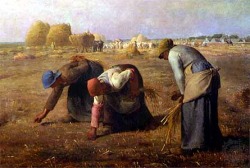
When I hear the term gleaners, the famous painting by Francois Millet hanging in Musee D’Orsay depicting a historical and extinct practice immediately comes to mind. The Gleaners and I, filmed by Agnès Varda in 2000, explores the modern meaning of gleaning and how prevalent it is in French society. Filmed by a middle-aged woman unafraid to ask questions, the documentary follows the events of people in every stage and of every occupation in life. She interviews homeless people who rely on potatoes for their survival, a painter who gathers scraps for inspiration, and men in Paris who actively search for fridges, fruit, meat, and anything else they can get their hands on to decorate their home they term “better than paradise.” Symbolic of the human, real nature of modern gleaning is the collection of heart-shaped potatoes that Varda finds towards the beginning of the film. It portrays the desperate attempt of people hoping to support themselves, while relying on scraps from others to fulfill their own lives. This documentary is meant to explore, research, and identify how gleaning is portrayed in the modern French society.
Particularly interesting is the way that Madame Varda identifies with her subjects. She calls them “picturesque” and “theatrical” when she learns of their struggles. One example was when she filmed the youths who had a run in with the law; instead of disparaging them for their actions, she focuses on their relationships with each other, their humor, and their ability to prosper in their lifestyle. This demonstrates Varda's willingness to put class, gender, and race biases aside to focus on her objective of categorizing different acts of gleaning within France.
The Gleaners and I serves as a powerful tool to show the world that people still struggle to endure everyday life. Even though not everyone searches fields after the crop has been harvested, some do still rely on trash to fulfill their hunger and needs for inspiration. The lonely yet positive mood of gleaning displayed is evident in each interview. While this film does indeed introduce awareness and expand knowledge of modern gleaning, it seeks to involve more subjects than is necessary, decreasing the effectiveness and primary focus of the documentary of modern gleaning
Particularly interesting is the way that Madame Varda identifies with her subjects. She calls them “picturesque” and “theatrical” when she learns of their struggles. One example was when she filmed the youths who had a run in with the law; instead of disparaging them for their actions, she focuses on their relationships with each other, their humor, and their ability to prosper in their lifestyle. This demonstrates Varda's willingness to put class, gender, and race biases aside to focus on her objective of categorizing different acts of gleaning within France.
The Gleaners and I serves as a powerful tool to show the world that people still struggle to endure everyday life. Even though not everyone searches fields after the crop has been harvested, some do still rely on trash to fulfill their hunger and needs for inspiration. The lonely yet positive mood of gleaning displayed is evident in each interview. While this film does indeed introduce awareness and expand knowledge of modern gleaning, it seeks to involve more subjects than is necessary, decreasing the effectiveness and primary focus of the documentary of modern gleaning
The Corporation (2003)

While watching The Corporation, I learned things I don't think I'm supposed to know. It was so poignant in its portrayal of the manipulation of the customer, the celebration of politics, and general disdain for individuality in our society. This documentary explored the birth, means, and motivations of corporations, branding them as "people" who have no souls and are only produced for profit. The directors, Marck Achbar, Jennifer Abbott, and Joel Bakan, interview countless CEOs, news reporters, authors, brokers, management gurus, and professors to delve into how the corporation has become such an integral yet parasitic partner of the American economy and culture. I thought it was extremely entertaining while it scared me into thinking that corporations were going to storm into my home and strip me of everything I have. This documentary has no frills; it exposes the qualms of news reporting, consumer goods, sweat factories, and much, much more. It even suggests that a company will one day own the rights to creating humans! I felt the The Corporation was successfully a "people's film." That is, it ventured to give vital information that is easily kept from the public. It was provoking, stylish, strong, and committed to showing every side of a corporation, good, bad, and ugly.
Born in the Brothels
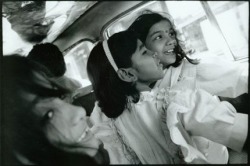
While this documentary is interesting in its content, it does have a higher, ulterior motive: to improve the lives of its subjects. Born in the Brothels is directed by Zana Briski and Ross Kauffman, who hoped to give the children they filmed the chance to become educated, more civilized citizens of India. They were intent on giving the children the opportunity to take classes and realize their potential. It was extremely interesting to be able to delve into such a unique, foreign lifestyle. Simple and straightforward, the title conveys a strong meaning for the film, signifying its powerful subject matter while presenting a true portrayal before the movie even begins. As a middle class American, I have not seen the poverty that threatens much of the rest of the world. I've been on mission trips and helped others as I have been able, but this film brings a new dimension of struggles and obstacles that children younger and more vulnerable than me have to overcome in their everyday lives. The directors strive to expose the red light district of India while encouraging the children of prostitutes to attend classes, becoming mentors and sources of sustainability. But as the children excel, they are somehow drawn back into the life that threatens to smother any chance of their chance at a successful life. One child, Avijit, goes on to higher education, while his peers drift back into the brothels, where they were born and hopelessly remain. This documentary was extremely riveting, emotional, and thought provoking for me to encounter; the directors showed the dynamics of a personal film and how it affected the people they confronted in their endeavors.
Brothers Lumière
